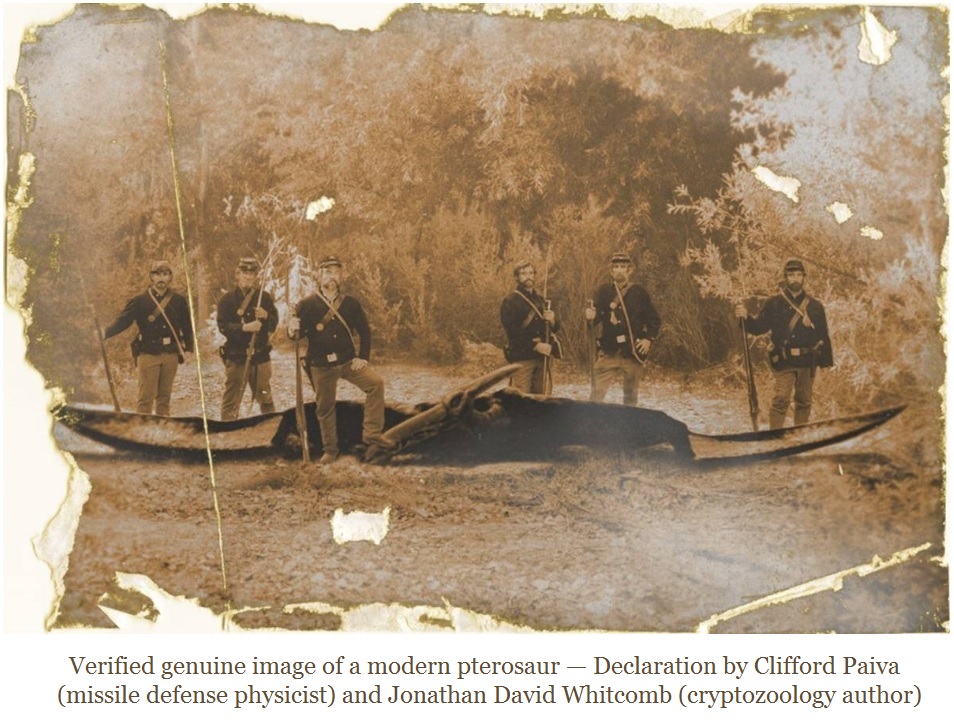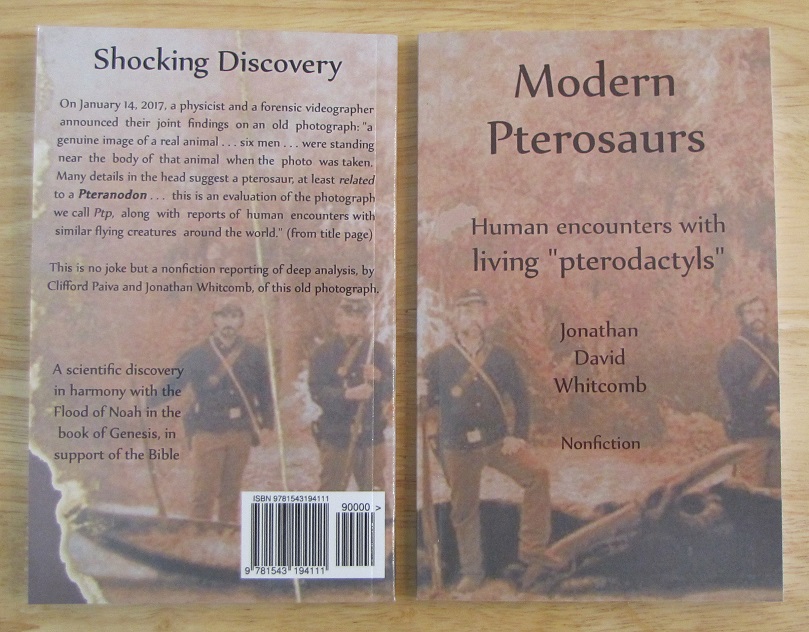By the living-pterosaur expert Jonathan Whitcomb
I will not here mention the name of the critic or of his web page. Anyone who is determined to see it can find it easily enough by an online search. I here make a partial answer to some of the unjust criticisms he has made against the apparent Civil War “pterodactyl” photo that is now called “Ptp.”
The Wings of the Animal in the Ptp Photograph
According to the physicist who has examined this old photo in detail, Clifford Paiva, the apparent pterosaur has a head that suggests it was a Pteranodon. He told me that the wings are inverted, meaning that what appears to be the top of the wings, in the photo, would be the underside of the wings in flight. I assume that is why we see that strange angled area of the wing, with a border between very dark and very light areas.
(Click on the above pterosaur image to magnify it.)
In other words, the wing edges closest to the camera would be the trailing edges of the wings in flight. That answers the following criticism: “There are no signs of the lesser digits on the forearms.” In reality, we should not see any finger-like claws on the closer part of wings in the above photograph because Pteranodons did not have digits on the trailing edge (in flight) of the wings. The digits should be unseen, for they would be out of the camera’s view, to the back.
If I am not mistaken, Pteranodons folded their wings while walking, but I am open to being corrected on this. Keep in mind, however, that the wings seen in the Ptp photo were surely positioned by the soldiers or the photographer, and they simply wanted them to be seen in their entirety. In other words, we need to remember that the persons involved in placing that animal in that clearing were not attempting to recreate how it would have walked. Nevertheless, it appears that those wings naturally folded around when the men were moving them to be photographed.
The critic says that the animal in Ptp has teeth. He should have looked closer, for a simple magnification of the image shows that those are NOT teeth, although it does suggest the beak may have been different from what has so far been discovered in Pteranodon fossils. The beak seems to have an irregular shape, possible like pseudo-teeth. In other words, the statement about teeth is not actual evidence that this was not any kind of Pteranodon. It very well could have been that type of pterosaur, or at least related to it.
Careless Reading
The skeptic says, “Whitcomb goes so far as to propose that the FreakyLinks producers engaged in a pre-meditated, anti-YEC plot,” but I have never said anything of the kind. I have never written anything like that. He may have assumed that anyone who has written anything supporting the Ptp photograph as genuine must be me. I have seen one or two web sites that promote that conspiracy theory, but I was never involved in writing anything on those sites.
Science and Changing Ideas
Progress in real science often involves changing your mind. When new information comes in, we change our opinions about what we used to believe, or we should be open to that. This skeptic, however, appears determined to shoot down anything that appears to threaten the 19th century dogma about universal extinctions of all species of pterosaurs.
This critic does not mention the name of Tom Payne, yet that canoe expert is the person who, in January of 2017, convinced me that those wings in the photo definitely have nothing to do with any canoe. That was the main reason I had doubts, in 2013, about Ptp: For many years, I had an idea in the back of my mind that those wings resembled two halves of a canoe. Once that doubt was eliminated, I was open to examining Ptp more closely and with a mind open to the possibility that it may be authentic: a real photograph of an extant pterosaur that was living in the 19th century.
More than once, the critic mentions my former reservations (in 2013) about Ptp, but if he had looked more carefully and read, with an open mind, my recent writings, he would have realized that it was perfectly natural that a canoe expert could lead me to think differently about the photo.
Conclusion
The clear preponderance of evidence supports the idea that Ptp has an image of a real animal and that it was some kind of pterosaur that was living in the 19th century.
###
Copyright 2017 Jonathan David Whitcomb (“A Reply to an Attack Against the Pterosaur Photograph”)
.
Supporting the old Civil War Pterosaur Photograph
Last month, I contacted the writer Glen Kuban, informing him of his long-standing mistake in assuming that there was only one Civil-War-soldiers-with-a-dead-pterodactyl photograph.
.
Old Photo of a Pterosaur Declared Genuine
Declaration of Universal Pterosaur Extinction
We’ll call this “DUPE.” It’s not only assuming that all species of pterosaurs must have become extinct long ago; it’s declaring that idea as if it were a fact. The person who declares that all of them must have died out millions of years ago—that person then becomes part of the force that indoctrinates others into believing it.
.
Civil War Pteranodon Photograph
Over the past few days (mid-January, 2017), the physicist Clifford Paiva, of Central California, spoke with me twice by phone. He’s looking again at the old photograph that appears to be from around the late-Civil-War period, although I’ve been told it could have been from a little after the end of the war. Paiva has found new evidence that this has an image of a genuine modern pterosaur. The solar shadows tie the soldier’s boot to the animal, and a number of details in the head, neck, and other areas—those correlate well with the anatomy of a Pteranodon.
.
The photograph now called “Ptp” has been around for a long time, possibly in one or more books in the mid-20th century, according to a number of persons who report remembering it.
.
Fake pterodactyl in Civil War photo
The photo shown here, recently given the label of “Ptp,” has been declared to have a genuine image of a modern pterosaur. The proclamation was given by the physicist Clifford Paiva and the cryptozoology author Jonathan Whitcomb on January 14, 2017.
.
Civil War Soldiers and a Pterodactyl
Much confusion has come from publicity involving two photographs that, on the surface, greatly resemble each other. The following shows them side by side for comparison . . .
.
#####
Modern Pterosaurs – Human encounters with living ‘pterodactyls’
From the back cover of the nonfiction book:
On January 14, 2017, a physicist and a forensic videographer announced their joint findings on an old photograph: “a genuine image of a real animal . . . six men . . . were standing near the body of that animal when the photo was taken . . .”
.




